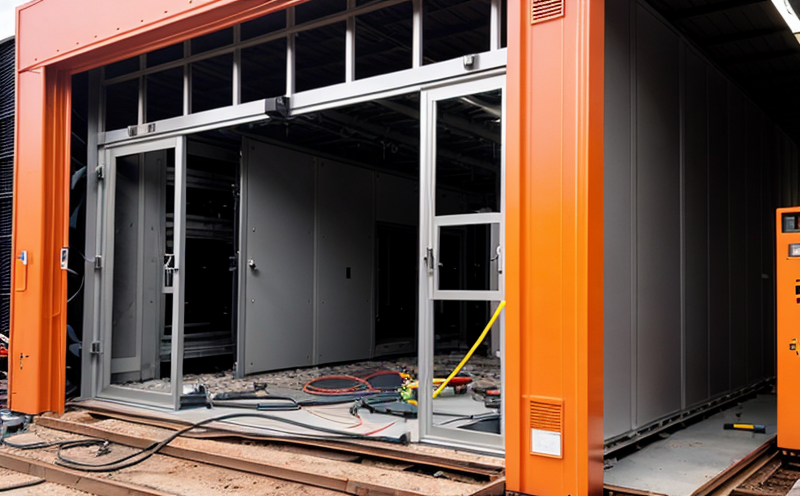ASTM E2395 Thermal Performance Testing of Lithium Batteries Under Extreme Conditions
The ASTM E2395 standard is pivotal in ensuring that lithium batteries are robust against overheating, which is critical for the safety and reliability of portable electronics, electric vehicles, and other battery-powered devices. This testing procedure involves subjecting lithium batteries to extreme thermal conditions such as high temperatures, rapid temperature changes, and controlled heating rates.
The standard is designed to evaluate the thermal stability and performance of these batteries under simulated real-world scenarios. The test aims to identify potential risks associated with overheating, which could lead to fires or explosions if not properly managed. By adhering to this procedure, manufacturers can ensure that their products meet stringent safety requirements set forth by regulatory bodies.
The testing process typically involves placing the battery in a controlled environment where it is subjected to various temperature cycles and exposure durations. The goal is to observe how the battery behaves under these conditions over time, including changes in voltage, resistance, internal temperature, and any signs of thermal runaway.
One key aspect of ASTM E2395 is its focus on preventing thermal abuse scenarios that could lead to hazardous situations. This includes testing batteries for their ability to withstand exposure to direct sunlight or high ambient temperatures, as well as assessing their recovery capabilities after such exposures. The standard also considers the potential impact of mechanical shocks and vibrations on battery performance.
Another important element is the evaluation of thermal management systems integrated into devices that use lithium batteries. These systems are designed to regulate heat generation and dissipation within the device, ensuring safe operation even when exposed to adverse environmental conditions. By incorporating ASTM E2395 into their development processes, manufacturers can verify the effectiveness of these thermal management strategies.
The testing procedure outlined in ASTM E2395 provides a comprehensive approach to assessing battery safety by simulating various worst-case scenarios that might be encountered during use. This ensures that batteries not only meet current regulatory standards but also perform reliably under conditions likely to be experienced by end users.
Why It Matters
The importance of ASTM E2395 cannot be overstated, especially given the increasing demand for portable electronics and electric vehicles. As these devices become more powerful and energy-efficient, so do their batteries, which produce higher amounts of heat during operation.
- Enhanced Safety: Ensuring that lithium batteries can withstand extreme temperatures helps prevent fires or explosions caused by overheating.
- Regulatory Compliance: Meeting the requirements set forth in ASTM E2395 demonstrates commitment to adhering to international standards, which is crucial for market access and consumer trust.
- Improved Product Quality: By identifying thermal vulnerabilities early in the design process through rigorous testing, manufacturers can enhance product durability and reliability.
The stakes are high when it comes to battery safety. A single incident involving a lithium-ion battery fire or explosion could have severe consequences for both consumers and companies alike. Therefore, investing in thorough thermal performance testing is essential not only for compliance but also for safeguarding against potential risks associated with product misuse.
Competitive Advantage and Market Impact
Adhering to ASTM E2395 can give companies a significant competitive edge in the marketplace. In an era where sustainability and safety are increasingly important considerations for consumers, demonstrating a commitment to rigorous quality assurance practices sends a strong message about a company's dedication to producing safe products.
Besides enhancing brand reputation, successful completion of ASTM E2395 can lead to increased customer confidence and loyalty among buyers who value reliability above all else. Additionally, companies that excel in meeting these standards may find themselves better positioned to negotiate favorable terms with suppliers or partners due to their proven track record of delivering high-quality products.
Moreover, compliance with ASTM E2395 can open doors to new markets and opportunities for growth. Many countries have stringent regulations regarding the safety of lithium batteries, particularly those used in consumer electronics and automotive industries. By ensuring adherence to these standards early on, manufacturers can avoid costly delays or even bans when entering such markets.
Use Cases and Application Examples
| Use Case | Description |
|---|---|
| Laptop Computers | ASTM E2395 helps ensure that laptop batteries can safely handle the heat generated during prolonged use or when left in hot environments like vehicles parked outside. |
| E-Bikes and E-Scooters | The standard ensures that lithium batteries used in these devices are capable of withstanding extreme weather conditions, including high temperatures encountered while being ridden outdoors. |
| Smartphones | This testing is crucial for smartphone manufacturers to guarantee that their products can function safely even when exposed to direct sunlight or hot climates. |
| Electric Vehicles (EVs) | Evaluating the thermal stability of batteries used in EVs helps prevent overheating issues that could compromise driving range and pose safety risks during long trips. |
- Battery Packs for Portable Power Stations: Ensuring battery packs can withstand high ambient temperatures without failing is essential for outdoor enthusiasts who rely on these stations in various weather conditions.
- Solar-Powered Devices: Testing batteries used in solar-powered devices helps confirm their reliability under changing environmental factors like fluctuating sunlight intensity and temperature variations.
- Aerospace Applications: For aerospace applications, ASTM E2395 ensures that lithium batteries can operate safely at high altitudes where temperatures vary widely between day and night.





